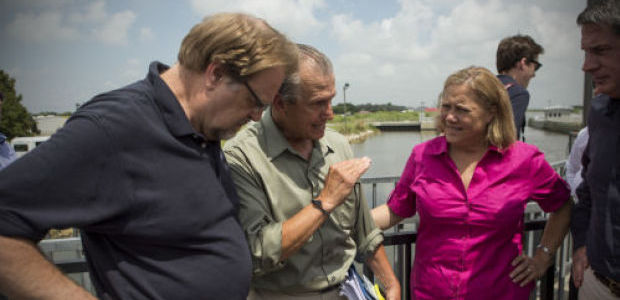
199 Years of Memories: Lafourche sisters recall their century (so far) of living
August 13, 2013Council refuses property tax hike
August 13, 2013A ranking FEMA official who oversees the nation’s flood insurance program got an eyeful and an earful of local concerns and woes regarding both agencies last week, during a series of meetings and tours on land and air.
David Miller, administrator of the National Flood Insurance Program and associate administrator of the Federal Emergency Management Agency, said the whirlwind tour afforded him an opportunity to better understand the complex economic and social issues in Terrebonne, Lafourche and surrounding areas, which could help ease the potential effects of pending flood insurance increases business and government leaders say could deal the region a crippling blow.
“It’s all stuff that we have discussed but it reinforces some of the important things,” Miller explained, after a tour of the region last Thursday. The visit was preceded by a flyover of levee fortifications and southeast Louisiana.
“It’s one thing to have flown but seeing it on the ground is a little bit different, it reinforced some of the important pieces of it that we learned as we flew over.”
Contact with workers at various sites, who indicated their commitment to the region not just as a place to work but also to live made an impression on the administrator.
“It’s one thing to have an economy in a given area, but the fact that the workers are there and they are not going to leave feeds the economy, and shows it has more of an outreach than just just right here.”
The tour, which was followed on Friday by a meeting with Terrebonne Parish officials, provided Miller with a better understanding of the work local communities have done in terms of raising their own flood protection projects, and how they might affect the ultimate decisions by FEMA on what protection exists.
The agency has begun a pilot program that will take into account locally constructed flood-protection projects when determining the vulnerability of a given area, and Miller said the information he amassed is adding to the store of knowledge in terms of how those projects relate to the bigger picture.
“It is an important thing to consider the investment that has been made by the local government and the state in protecting themselves,” Miller said. “For us that means going back as we are in our levee analysis and mapping process and looking at that.”
The science involved with flood protection, Miller said, is what ultimately will prevail.
“At the end of the day it’s how do we look at the science and how we apply the science and how it affects the rates overall.”
Other factors such as population in given areas, Miller said, have an effect on decisions at his agency’s level.
Miller made the trip at the request of Sen. Mary Landrieu, D-La., who accompanied Miller along with Sen. David Vitter, R-La., and various local levee and flood control officials.
Local communities are dealing with two issues involving their relationship to the federal government.
A long-standing point of disagreement has involved the official maps that FEMA uses to identify flood risk. Officials in Terrebonne and Lafourche have long maintained that the maps, which ignored the existence of non-federal levees and flood control structures, dramatically overstate flood risk in their communities, leading to the potential of higher flood insurance rates, or the requirement that some structures be raised above certain heights to decrease flood risk, an expensive proposition.
But a separate issue involving flood insurance has centered on the Biggert-Waters Act, the reauthorization of the national program signed into law last year after passage by Congress.
Biggert-Waters represented a profound philosophical and operational shift for the program, and eliminated a grandfather provision that kept rates affordable for homes in high-risk areas but which had not flooded in the past.
Landrieu said a fix to Biggert-Waters could take some time, but that adjustment of FEMA maps, particularly in light of the recent pilot program, could have a more immediate positive effect on communities.
The helicopter tour included a look at flood protection infrastructure including the Lake Pontchartrain drainage canal floodgates and levees in St. Tammany, Plaquemines, Jefferson Lafourche and Terrebonne parishes. The delegation then traveled by bus for a closer view of the levee system in Lafourche Parish before returning to the helicopter for a final tour of levees in St. James, St. John the Baptist and St. Charles.
Later that afternoon Landrieu and Miller joined officials from 23 parishes and representatives from the banking, real estate and home building associations for a forum on flood insurance. Parish officials had an opportunity to speak directly with Miller about the National Flood Insurance Program, the mapping process and reform legislation.
“I hope Mr. Miller’s visit has given him a much needed, first-hand view of the local flood protection infrastructure our communities have built. FEMA’s current flood rate maps don’t take into account our local efforts and this visit is integral in helping us get the credit we deserve,” Landrieu said. “Bringing together our parish presidents to speak face-to-face with Mr. Miller was a positive step forward to make flood insurance affordable, accessible and self-sustainable for Louisiana. I hope FEMA will use what they’ve learned here today to establish a plan to help residents afford the insurance protection they need.”
Reggie Dupre, executive director of the Terrebonne Levee and Conservation District, who joined the officials in the tour and the forum, said an acknowledgment of local flood protection investment by FEMA is long overdue.
“We’ve done the work, we’ve put the money in, and we should get credit for it on flood maps. Sen. Landrieu is committed to working to get us the credit we deserve and I thank her for her leadership and partnership,” Dupre said.
Lafourche Parish President Charlotte Randolph said she saw the tour as “an incredible opportunity to show FEMA the reality on the ground in Lafourche – that our local levees do provide protection for our communities.”
“I am hopeful that FEMA gained a better understanding of what it means to live along the coast so they can recognize the significant investments we’ve made in flood protection,” said Randolph.
On July 13 Landrieu announced that her Homeland Security Appropriations bill would prevent FEMA from ultimately raising rates on grandfathered properties.
“These are homes and businesses that were built to code and were subsequently placed into higher risk areas on a flood map,” Landrieu explained. The bill passed the Senate Appropriations Subcommittee and is still in the review process.
The measure was first passed through the House under the leadership of Rep. Bill Cassidy R-Baton Rouge.
The bill blocked FEMA from using its 2014 budget to implement the higher premiums dictated by Biggert-Waters.
Both Landrieu and Cassidy – an announced seeker of her Senate seat in the upcoming 2014 election – have been hard at work dealing with the Biggert-Waters problem and FEMA-related issues such as the maps.
Cassidy was also present during last week’s tour, and thanked Miller for agreeing to take a hands-on look.
Vitter was present for the tour, and during a brief news conference took an opportunity to make a pitch for flood protection cost relief and to side-swipe President Barack Obama.
In his remarks, Vitter noted that Obama has said aspects of his prized healthcare plan – dubbed Obamacare – were “not ready for prime time.”
Vitter said he wants the President to acknowledge that aspects of Biggert-Waters are not ready for prime time either.
The meeting with Terrebonne officials was set up prior to Thursday’s event, through communication over time between Parish President Michel Claudet and Miller. The two have communicated frequently over the past year, and as a result of that Miller had requested the meeting, Claudet said.
“We wanted to show them that we are doing what we are supposed to do in order to live in the environment that we are in,” Claudet said. “We are playing by the rules. This by far is the largest single issue that has faced Terrebonne certainly since I have been parish president. It certainly appeared that Mr. Miller understood what we were trying to advise him of.”
David Miller, administrator of the Federal Emergency Management Agency’s National Flood Insurance Program, Lafourche levee director Windell Curole and U.S. Sens. Mary Landrieu and David Vitter discuss storm protection in the Tri-parish region.










